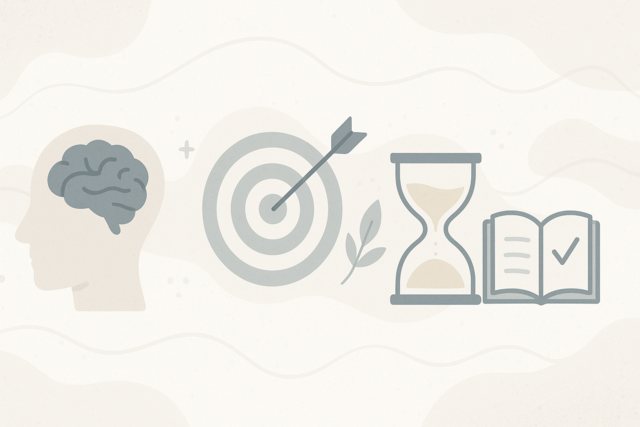To reduce the number of times your eyes stop, you need to train the eyes to see a larger area of the page each time they do stop. Through drills and practice, you are able to see more of what you're reading and stop focusing on each individual word. With practice and patience, you will be able to take in more of the printed page while you read and reduce the amount of movement that your eyes make, which makes for faster and more efficient reading.
Reading Drill 1
Eye drills are absolutely essential to your success at increasing your reading speed. There are several exercises that you can use and they can be done for just a few seconds when you have time, or you can really focus on them and do them for more extended periods of time. With practice and patience, you will find that you're able to increase your visual "bite."
For this drill, focus your eyes on the center column letters of each line. Without moving your eyes left or right, read each set of three letters in this order:
- Center letter
- Left letter
- Right Letter
Then move your eyes straight down to the next line and repeat the process until you complete the drill.
The width of this drill is 1 � inches, which is about the average area required for an untrained speed reader to see well enough to read the three letters with little effort.
The first time you read through this drill, you may experience some difficulty. If so, repeat it several times. Pay attention to your eyes and focus on not moving them left to right. Try to read straight down without moving them at all. As you repeat the drill, you will find that it becomes much easier to do this and you will slowly be increasing your visual depth. If you use the camera analogy from earlier, you will be able to zoom out and see more of the picture you are reading.
Proper Practice
No matter what you're studying, you need to practice properly to get it right. The same is true when you're running through the various drills you will find in this article. The main key to remember while practicing reading drills is to simply relax. You will make several mistakes at first, but that's why you're practicing! Your main purpose at this point is to simply retrain your eyes to read differently and more efficiently. Your accuracy will improve as your eyes learn and your vision span increases. The second key of practice is patience. Don't stress out and don't rush, do it at a good pace and once you do it correctly at that pace, gradually increase your speed. Finally, master one drill at a time before moving on to the next.
If you practice frequently for short periods of time, you will find that you do not get tired as quickly. Short practice sessions are better than long sessions, as it easy for the eyes to become tired doing some of these reading drills, as the eyes have most likely never worked in this manner in the past.
Reading Drill 2
For Reading Drill 2, practice aloud and silently, reading the letters in this order:
- Center
- Immediate left
- Immediate right
- Far left
- Far right
Once you have mastered Drill 1 and 2, you will want to move on to 3, 4 and 5. Master each drill before you move on to the next. Each time you practice, begin with Drill 1 and then move up to the next drill through the natural progression.
When you get to Drill 5, you will notice that the width of the drill is much wider now. It is actually the typical column width of most paperback books. When you can read Drill 5 well, you should be able to read straight down the page without moving your eyes left or right.
Because the majority of people are taught to read aloud in school, switching to reading silently is not something that everyone can master. Vocalization when reading is simply reading aloud. Reading quickly aloud is difficult for people, as they can't always speak as fast as they would like to read. Even if you do not read aloud completely, you may be guilty of subvocalization. Subvocalization is essentially no different than reading aloud; it's just that you don't necessarily get whole words out, but rather different types of sound or puffs of air. If you are unable to break a habit of subvocalization, you are likely going to be stuck at a reading rate that is the same as your speaking rate, which is about 150 wpm for most people.
There are several forms of subvocalization that will slow down your reading. These include:
- Lipping
- Tongue Warbling
- Jawing
- Adam Appling
- Diaphragming
Lipping
Many slow readers "lip-read" as they read. They often have several eye stops as they go. The slowest of readers will actually almost speak each word aloud as they go. There are also those who whisper as they read. This reader appears to be lipping, but at the same time they are also whispering to themselves. This practice is time consuming and it also does not allow you to improve your reading because you're unable to read faster than you speak. To determine if you are a "lipper," place your finger on your lips as you read silently. If your lips move, then you are lipping as you go.
This habit is easy to break for most people. If you are aware of the fact that you do move your lips while reading, you will be able to use the following to stop this habit.
1. Place your hands in a cup shape behind your ears. This will help you hear if you whisper while you read and will allow you to consciously stop the habit.
2. Read with a pencil between your lips, holding it tightly. Any movements will make the pencil move and you'll be able to stop. Practice holding the pencil still as you read.
3. In severe cases, you may need to tape your lips shut. Yes! Some people are only able to stop this habit by placing a piece of plastic tape over their lips.
Tongue Warbling
Tongue warbling is when you utter sounds as you read. This practice is when the reader moves the tongue in the mouth as they read and you may have to concentrate on person's throat to even see that they are doing this as they read. Inside the mouth, the tongue is busy making every movement associated with speaking the words they are reading.
While you read, if you feel your tongue making movements that are not associated with breathing, then you may have the slightest hint of this habit and you need to break it. The following methods are common cures for this bad habit:
1. Read with a pencil gripped midway back in the mouth with the tongue held down by it.
2. Read with chewing gum between the top of your tongue and the roof of your mouth.
3. Hold your fingers beneath your jaw as you detect tongue movements.
Jawing
A person who "jaws" is one who moves his or her jaw as they read, almost as though they are speaking. It may also look like the individual is chewing. In order to overcome this habit, use the following:
1. Read with your chin resting on your clinched fist, with your elbow planted on a desk or table.
2. Read while you gum, but don't make movements that mimic reading your words.
3. Practice reading with a pencil clinched between your front teeth.
Adam's Appling
This habit is most common in male readers who move their voice box in the same manner as he would when speaking, but without making any sound. This reader even raises the pitch of his words, although he does so silently.
You can check yourself by placing your fingers lightly on both sides and the front of your Adam's apple. If there is any vibration or movement, then you are guilty of this habit. Use these methods to break it.
1. Consciously and deliberately relax your throat and neck. Stop occasionally while you read to roll and turn your head, and take a deep breath.
2. Continue to read with your fingers placed on your voice box and feel for any vibration or movement that will tell you to relax.
Diaphragming
The final bad habit that many readers develop is called "diaphragming." This individual reads silently, but regulates their respiration so that it corresponds with their words, phrases or sentences. Unconsciously, this person is regulating how they breathe as though they were speaking, but without making a sound.
To test yourself for this habit, place a finger beneath your nose and feel for any erratic air flow. Then, place your hand on your stomach area, just below the ribs, and feel for movement of the diaphragm that corresponds with the words you're reading.
This practice can be broken by reading with your hands placed just beneath the ribs. You should breathe normally while reading, but not in breaths that mimic the words on the page you're reading.
























